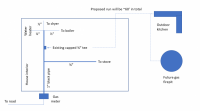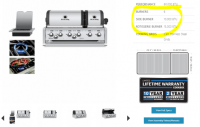Richard Spackmann
New Member
I have a 1" black pipe main trunk inside my house coming directly off the meter as shown on the attached diagram.
I am in the process of adding an outdoor kitchen - the specifications of the bbq is also attached - total of 85,000 BTUs.
I already have 1" pipe to run from the trunk to the outdoor kitchen, I obviously know that bigger pipe won't hurt, but I'm concerned about the 3/4" tee that it will be connecting to.
In looking at tables regarding BTUs, pipe size and length (also attached) - it looks like a 3/4 pipe would be more than enough to provide somewhere around 110 BTUs (at 60') - but the problem is that if you take into account for a potential of adding a gas fueled fireplace at some point (TBD) - that 3/4" probably won't supply enough for both.
Questions:
1. will the 3/4" tee negatively affect the available capacity - and by how much? (i.e. will it negate the upsize to 1" all together and negate the advantages?)
2. do I need to remove that tee (a fair amount of work) and just replace the 3/4" tee with a 1" tee so that everything going out to the bbq is 1"?
3. is there any concern about the possible outdoor fireplace? (obviously I don't have a spec or anything so I realize in advance that is hard to answer, looking for more of a gut feel - i.e. "because you ran 1" unless you have a nuclear sized firepit you should be fine")
Many thanks in advance...
I am in the process of adding an outdoor kitchen - the specifications of the bbq is also attached - total of 85,000 BTUs.
I already have 1" pipe to run from the trunk to the outdoor kitchen, I obviously know that bigger pipe won't hurt, but I'm concerned about the 3/4" tee that it will be connecting to.
In looking at tables regarding BTUs, pipe size and length (also attached) - it looks like a 3/4 pipe would be more than enough to provide somewhere around 110 BTUs (at 60') - but the problem is that if you take into account for a potential of adding a gas fueled fireplace at some point (TBD) - that 3/4" probably won't supply enough for both.
Questions:
1. will the 3/4" tee negatively affect the available capacity - and by how much? (i.e. will it negate the upsize to 1" all together and negate the advantages?)
2. do I need to remove that tee (a fair amount of work) and just replace the 3/4" tee with a 1" tee so that everything going out to the bbq is 1"?
3. is there any concern about the possible outdoor fireplace? (obviously I don't have a spec or anything so I realize in advance that is hard to answer, looking for more of a gut feel - i.e. "because you ran 1" unless you have a nuclear sized firepit you should be fine")
Many thanks in advance...




